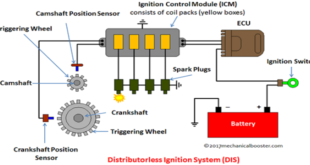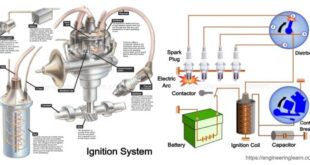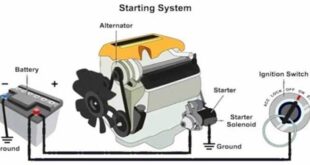INTRODUCTION
Automobile uses different types of lights like head light, park light, stop light, number plate light, interior light etc. These lights have to blow as and when required. Separate circuits are necessary for this purpose. The unit illustrates various lighting circuits and their working. Students can identify various headlamps, lighting switches, and warning lights.
It also describes the circuit diagram of the directional indicator and horn. The unit also deals with the construction and working of electric horn, windshield wiper, and function of the speedometer, odometer, Centre lock, and power windows.
LIGHTING CIRCUIT
The purpose of the lighting system is to provide illumination for the driver to operate the vehicle safely at night, to convey information to the other driver and people on the road about the vehicle’s presence, position, size, and direction of travel, illuminating instruments on the dashboard, etc.
HEADLAMP
A headlamp is a lamp attached to the front of a vehicle to light the road ahead at a reasonable distance with sufficient intensity. For this purpose, a reflector is used. The following are the important types of headlamps.
LIGHTING SWITCHES
Switches used in the lighting circuit of an automobile are of different types depending upon their requirements. The important switches are
- a) Light switch: – This may be of a push-pull type and is mounted on the board. It has three positions (i) off position, (ii) side lamps, tail lamps, number plate light, and instrument lamps (iii) headlights. This switch is also mounted on a stick on the steering column.
- b) Dimmer switch: – This switch is mounted on the stick on the steering column. By moving the lever up and down, we can select the dim and bright position of the headlamp.
- c) Stop light switch: – This is attached to the master cylinder in the brake system. When the brake pedal is applied, the fluid pressure developed in the compression chamber is communicated to a metallic diaphragm which deflects to close the two terminals for the stop light switch.
DIRECTION INDICATOR CIRCUIT
One light on each side is fitted both at the front as well as on the rear side of the vehicle. The wiring diagram for the same is shown in the figure. The current is taken from the battery through a fuse and a flasher unit.
The flashing indicator switch is usually in the form of a horizontal lever mounted on the steering column so that when its outboard end is actuated upward, the light side indicator lights are operated and the downwards movement of the switch arm operates the right side indicator lights.
The Flasher unit consists of a thermostatic bimetallic blade. The blade expands due to the flowing of the current through it, warms, and opens a pair of contacts, thus opening the circuit. But as the current stop flowing, the blade cools and straightens to close the circuit again. In this way, the lights are made to flash.
HORN CIRCUIT
The horn employed on present-day automobiles is electrically operated. The construction of such a horn is shown in figure. It consist of a diaphragm and an armature inside a field coil.
When the driver pushes the horn switch, the circuit is completed and the field coil produces an e.m.f. which causes the armature and along with it the diaphragm, to move down.
But the moment the armature moves down, the contacts separate opening the electrical circuit. The field coil is then de-energized and the armature again moves up on account of the force of a mechanical spring (not shown) which keeps it in the uppermost position. This upward movement of the armature causes the contacts to close again, thereby pulling the armature and the diaphragm down.
Last word
In this way, the diaphragm starts vibrating up and down causing the vibrations of the air column below it. These vibrations of the air column subsequently produce the horn sound, which depends upon the frequency of diaphragm vibration. A relay is usually inserted in the horn circuit. It protects the contacts at the horn button and provides a more direct connection between the horn and the battery.
 NEWSHUNTS
NEWSHUNTS



